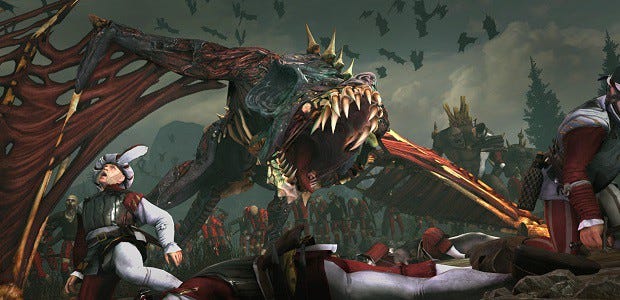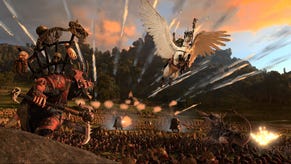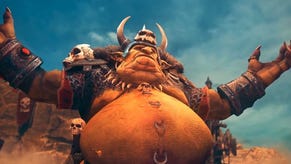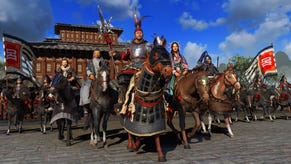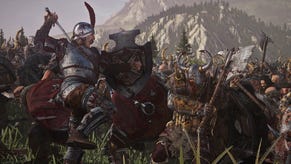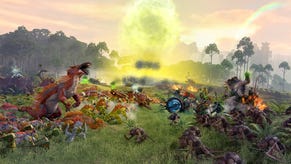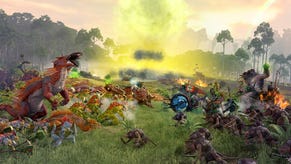Hands On With Total War: Warhammer's Vampire Counts
The Death of the Party
Bleached white bone is the new black, undead immortality is the new 30 and death is the life of the party. Playing as Total War: Warhammer's undead faction, the Vampire Counts, injects some fresh mechanics into the long-running strategy series' blood and provides plenty of evidence that this will be far more than a fantasy paintjob applied to well-worn rules and mechanics.
There are two main reasons for my newfound faith: the ability to resurrect the fallen and the existence of giant flying monstrosities that eat archers for breakfast. Welcome to Sylvania, the rotten heart of the Old World.
Both the strategic map and the tactical battles of Total Warhammer are clearly cut from the same cloth as those in The Creative Assembly's historical titles. The interface is similar, the landscapes are populated by similar troops of tiny people, and settlements follow a roughly approximate path of building upgrades. If you were to play the game with your historical hat on, you'd be in for a rude awakening though.
The undead don't behave like any faction previously seen in a Total War game. That makes sense. They shouldn't. Even the most militant and war-ready hordes can't repopulate the ranks of their warriors quite as efficiently as an army capable of raising the dead and commanding them to fight. And yet I wasn't willing to dismiss the nagging suspicion that Total Warhammer would fail to embrace the fantastical fully until I'd tried it for myself.
Before plunging into the positives – and there are plenty – there are two things to keep in mind. The first, broad point is that Total War games can look much stronger in a preview than in their final form. That's not because of any sleight of hand on the part of the developers or publishers, it's a symptom of the flaws that only become apparent after prolonged play. Even half a day spent with one of these behemoths doesn't provide enough time to construct a meaningful analysis of the AI, in either the strategic or tactical layers, and any potential mid- and late-game slog obviously wouldn't be apparent.
The second point is specific to this preview and to the Vampire Counts. Of all the Warhammer factions included in the game, they're the one most likely to upset the applecart. That's a good thing in this case – the applecart has been sitting there for far too long selling the same old apples – and it means that the usual Total War formula might be more apparent when playing as the other factions. We're at the edges of strategic possibilities and shapes with the undead, playing with unconventional methods, and that makes them an ideal representation of the game's fantastical elements.
Essentially, if I'd spent a couple of hours playing with the Empire, this might be a very different preview. In the context of the game as a whole, it makes sense for the factions to have unique playstyles and also to have at least one that hews close to the more traditional rank and file of a historical army, but I'm glad that my first experience of Total Warhammer was at the weird and wild end of the spectrum.
The best way to summarise exactly how weird and wild my time with the undead turned out to be lies in a conflict between myself and a fellow vampire. He was a neighbour, seemingly holed up in a haunted keep that he called home, and we were both attempting to carve out some new territorial claims in lands occupied by the living. That swiftly brought us into conflict with one another and we were soon picking through the bones of the armies we'd demolished in a big brouhaha at the border between our realms.
Inter-faction fighting, in the early stages of a campaign at least, might be extremely common. Even if you want to make a beeline for Karl Franz's head, that's all well and good, but you're likely to be surrounded by chieftains, counts and kings of your own kind who have made similar plans. Alliances are all well and good, but eventually the fur and flesh is going to fly.
With around 20,000 undead now redead on the outskirts of my territory, I turned my attention to recruiting new units. Basic undead, in the form of zombies and skeletons, are cheap. They're also rubbish. Zombies are the worst, the absolute worst, useful for absorbing the enemy's blows for a while but barely capable of shuffling across a battlefield.
Undead units don't have morale, presumably because they're the unconscious puppets of the necromancer who raised them, so they'll never flee. But they will crumble. It's the perfect verb to describe their performance, crumbling. They're like biscuits assaulted by too-hot tea, their rotten flesh resolving into clots and crumbs.
Crumbling occurs when undead are flanked or surrounded, and causes them to lose units at an alarming rate. My zombie masses tended to crumble before they'd made any impact whatsoever, limping toward the enemy and then disintegrating shortly after impact. They're rubbish.
And that's the point. The undead are as specialised a faction as I've ever seen in a Total War game. Their lords are capable of wading through crowds of infantry units, sweeping them aside with a combination of brute force and dark magicks, forming the focal point of many an attack. They have no ranged units whatsoever, which makes initial deployment deceptively simple, and the early stages of a battle a desperate attempt to cover ground quickly. That's a drag when so many of your units are barely capable of standing upright, malformed and mutilated as they are. Tactical choices emerge, however, particularly when flying units are thrown into the mix.
Flying units look spectacular. It's somewhat disappointing to find that the first tier critters can't deal much damage and are more useful when deployed to harass an opponent's ranged units, disrupting plans rather than destroying enemies. Tactically helpful but lacking the blood and thunder I hoped for.
The vargheists, which I started to recruit toward the end of the play session, do not lack in blood or thunder. They're enormous things and when the crash down in the midst of a crowd of archers, they pluck individual people off the ground and carry them into the sky, screaming and panicking. They thrash and tear, sending men tumbling head over heels, and when one set of imperial warriors broke and ran, the vargheists pursued, using their wingtips as a second pair of legs in a way that was both comical and vaguely terrifying.
There's a confusion to the battlefield, stemming from the fact that each faction has the means to outmaneuver the others, and that feels fresh. Deploying a ludicrous mass of zombies as a wall of flesh that must be contained before it gets too close to vulnerable units works as a method to distract from the surgical vargheist strikes that take out precious units that have nowhere to hide.
The fresh feeling carries through to the strategic map. All of those units that died on the borders of my land? They're ripe for the picking and can be raised again - as weak, trashy fodder – to form the crumbling backbone of a new army. Or perhaps the fleshy protective shield around a backbone made up of stronger units.
When a major battle takes place in the world, it's marked on the map and a undead lord who travels to the spot can raise the fallen to create a makeshift horde, or to bulk up an already-existing army. It makes them very tricky opponents to right as they're capable of creating something out of (seemingly) nothing, constructing a ramshackle hindrance of an army. That can lead to unwanted distractions or even, as in my case, to a seemingly eternal conflict (I only played for 60 turns to 'eternal' is a stretch). Blood will have blood, ichor will have ichor and death leads to yet more pesky unliving warriors.
The combination of throwaway units recruited through unusual methods and specialised elite units is one side of the undead coin. On the other side there is the concept of corruption and blight. As you spread your influence across the map, the blight spreads with you. It's slow to take hold though, which can make conquering an arduous process. I'm not entirely clear on the specifics as to how it can be encouraged or the numbers that are being crunched, but sending out an advance party to occupy an enemy city can lead to catastrophe. Away from the necromantic influence of the vampiric lands, they suffer a horrendous rate of attrition and will crumble to dust before they can set up efficient siege defences.
What I find pleasing about all of this is that it supports the notion that Total War: Warhammer's factions will play different games, with their own possible strategies and tactics. There's a very strong sense of identity in both the world and in the Vampire Counts themselves, and if that carries through to every faction, part of the battle for hearts and minds will already be won.
The little that I played of the campaign was promising as well. The map is tighter than Rome II's sprawling monstrosity, which encourages the AI to create interesting scenarios. A dwarven stronghold that I'd pencilled in as my next target for conquest fell to marauding greenskins, who I had agreed a nonviolence pact with, before I'd dealt with problems elsewhere. And there was a lovely moment when an antagonistic neighbour backed down and offered peace plus a stack of gold when my lord came back from the dead in all his glory.
Named characters can die too, you see, and if you're playing as the undead, they'll become available to recruit again even if they fall in battle. That could lead to some interesting interludes – if a powerful hero falls but will rise again, there's a window of opportunity for his enemies to attack while the iron is hot (and he's cold, in the ground). I wish I'd had more time to explore hero skills and spells because they're obviously a key part of battle. As it is, along with a healing and life-leeching spell, I managed to unlock some magic that allowed me to raise a unit of zombies during battle, which seemed exciting until I remembered that zombies are garbage.
All signs are promising, then, but until we've played with all of the factions and seen how campaigns play out in their entirety, it's impossible to make any accurate forecasts. There's encouraging talk of varied end-games that avoid complete conquest of the map as the goal, which should negate that awful sense that you've tipped the scales toward victory but have to grind out the final provinces to get over the finishing line.
This much is true: I had a wonderful time with the game and the way the undead attributes have been threaded through the tactical and strategic layers seems smart. It also shows full commitment to the cause; this is as much Warhammer in a Total War costume as it is Total War in a Warhammer costume. More than either of those things, though, it's shaping up to be a broad, epic strategy game that isn't afraid to tackle the weirder side of life (and death), in both its rules and its setting.
Total War: Warhammer will be available to play at EGX Rezzed and is out May 24th.
